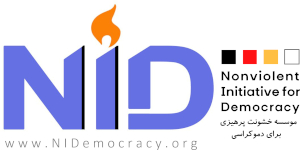For the past nine months, civil protests in Iranian universities have continued after the murder of Mahsa Amini in the custody of the Basij organization. Like nationwide protests in society, students have chanted the slogan “Women, Life, Freedom” and demanded a referendum and freedom of hijab.
Now, on the eve of end-of-term exams in universities, protests in the University of Art, with the support of other universities, have intensified the pressure on students.
Last week, the students of the University of Art received a text message from the university stating that veiling with a face covering (niqab) is now mandatory for women. The following day, on June 14, dozens of students protested against the compulsory veiling in front of the Faculty of Fine Arts at the University of Art. This protest continued until the early hours of Thursday. According to some reports, during this time, the fortifying students were threatened by plainclothes, security, and vigilante forces, and even the head of university security, who personally beat and injured several fortified students, sending them to the hospital.
Subsequently, on Saturday, June 17, the Telegram channel of the student trade unions reported that security forces violently arrested a large number of students from the University of Art in front of the National Garden Campus of the university. However, the independent channel of the University of Art students reported in the early hours of Monday that most of the arrested students had been released in the late hours of Sunday.
Also, on Saturday, June 17, a message was published by a group of students from the University of Art in some media outlets, addressing the authorities of the university and the authorities of the Islamic Republic. The message stated, “It has been nearly a year since we became like this, and we have only one word for you: No.”
The events at the University of Art have been met with a wave of support and solidarity, especially within the university community. Until June 19, students from 15 universities, including the University of Tehran, Mazandaran University, Ferdowsi University of Mashhad, Alameh Tabatabai University, Sharif University of Technology, K. N. Toosi University of Technology, the University of Tehran, and Tarbiat Modares University, released separate statements expressing their support for the protests of the University of Art students and strongly condemned the actions of security forces.
The Iranian Writers’ Association also reacted to these events in a statement. Part of the statement issued by this professional association reads, “There is no doubt that the responsibility for any harm to the students and anyone who is openly confronted with suppression and violence in pursuit of their demand for freedom and expression is on the officials and perpetrators of these suppressions.”
The University of Art has been one of the leading universities in non-violent civil protests. Many instances of revolutionary performances, slogan writing, and protest art by University of Art students have been published under the slogan “Women, Life, Freedom.”
Following the start of these protests, students from various universities across the country have staged defensive fortifications and protests in opposition to the repressive actions of security forces regarding compulsory veiling and the dress code for female students, and gender segregation in universities, as well as the issuing of heavy penalties by disciplinary committees against protesting students and creating a military and authoritarian atmosphere in universities.
Earlier, the student trade unions had reported that during anti-government protests in Iran, since the beginning of last autumn, over 500 students have been detained throughout the country, and hundreds of others have faced “repressive and unfair” penalties, such as suspension, expulsion, and educational bans, merely for participating in non-violent civil protests.



